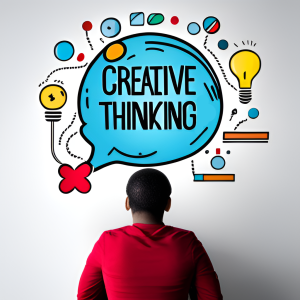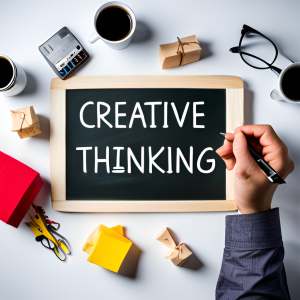How to Tap Into Your Inner Genius and Create Lasting Works of Art
Introduction: What is Creative Thinking and How Can You Access It?

Creative thinking is the ability to think in a new and innovative way. It is often associated with creative geniuses such as Leonardo da Vinci, but it is something that anyone can access. Creative thinking is an important skill for problem-solving, making decisions, and coming up with solutions to complex issues.
Thinking in a new and innovative way is a highly sought-after skill, especially in today’s fast-paced world. Having the ability to take existing ideas and build upon them, or create completely new ones can be incredibly valuable for organizations. This type of thinking requires creativity, problem solving skills, and the willingness to take risks. It also involves being open to diverse perspectives and being able to see problems from multiple angles. As technology advances, this ability will become even more important as it will allow businesses to stay ahead of the competition by coming up with creative solutions quickly.
Creative thought requires a certain level of imagination and focus on exploring ideas which are new or different from existing ones. It requires accessing your inner genius and using it to come up with creative solutions to problems. Creative thinking also involves being open-minded and looking at things from different perspectives while considering all possible outcomes before making any decisions. It also involves understanding the creative process so that you can better understand how to access your creative thought process in order to create something original and unique.
Understanding the creative process can be a challenging task. It requires you to understand why certain ideas come to mind, what makes them unique and how to transform them into something tangible. By understanding the creative process, you can develop effective strategies for generating ideas and creating content that stands out from the competition. You’ll also be able to identify potential pitfalls and roadblocks before they even arise. Ultimately, understanding the creative process is essential for any content creator or copywriter who wants to remain competitive in today’s digital landscape.
The creative process is the journey that individuals undertake to generate new ideas, concepts, or solutions to problems. It can be broken down into several stages:
- Preparation: This is the stage where you gather information and ideas related to the problem or project you are working on. You may research, brainstorm, or seek inspiration from other sources.
- Incubation: In this stage, you let the information and ideas you’ve gathered simmer in your mind. You may step away from the problem or project and allow your subconscious to work on it.
- Insight: This is the “aha!” moment where a new idea or solution presents itself. This can come from unexpected sources or through connecting seemingly unrelated pieces of information.
- Evaluation: In this stage, you critically evaluate the new idea or solution to determine if it’s feasible, practical, and effective.
- Implementation: This is the stage where the idea or solution is put into action. It may involve further refinement and iteration as it’s tested and evaluated.
It’s important to note that the creative process is not always linear and can involve going back and forth between stages. Additionally, the creative process is unique to each individual and can vary depending on the problem or project.
Understanding the creative process can help individuals develop their creativity and generate new ideas and solutions. By embracing the different stages of the creative process and allowing for flexibility and iteration, individuals can unlock their full potential and achieve greater success and fulfillment in their personal and professional lives.
Having the ability to come up with new and innovative ideas or solutions to problems. It involves using the imagination and thinking outside the box, often by making connections between seemingly unrelated ideas or concepts.
Accessing creative thinking requires a few key strategies:
 Create space for creativity: Set aside time and space for creative thinking. Find a quiet and inspiring environment where you can focus without distractions.
Create space for creativity: Set aside time and space for creative thinking. Find a quiet and inspiring environment where you can focus without distractions.- Stay curious: Keep an open mind and stay curious about the world around you. Seek out new experiences, read widely, and ask questions to expand your knowledge and understanding.
- Explore ideas: Allow your mind to explore ideas without judgment. Brainstorm, make lists, and let your mind wander freely. Don’t worry about the practicalities at first; focus on generating as many ideas as possible.
- Collaborate with others: Collaboration can spark new ideas and bring fresh perspectives. Work with others to exchange ideas, challenge each other’s thinking, and find innovative solutions.
- Take breaks: Allow yourself time to step away from the problem or project at hand. Take breaks, engage in other activities, and give your mind time to recharge and come up with new ideas.
- Practice creativity: Practice creative thinking regularly to develop your skills. Engage in activities such as writing, drawing, or brainstorming to exercise your creative muscles.
In summary, accessing creative thinking requires creating space for creativity, staying curious, exploring ideas without judgment, collaborating with others, taking breaks, and practicing creativity regularly. By using these strategies, you can tap into your creative potential and find new and innovative solutions to problems.
keywords: creative thinking, creative thought, creative process, creative genius, inner genius)
5 Steps to Unlock Your Inner Creative Potential
Are you looking to unleash your inner creativity but don’t know where to start? It can be hard to tap into your creative potential, but there are some steps that you can take to unlock it. From discovering your passion, to utilizing brainstorming techniques and idea generation tools, this article will provide you with the necessary steps to help you unlock your inner creative potential.
By understanding what drives and inspires you, engaging in creative activities and coming up with innovative ideas through brainstorming and idea generation tools, it is possible for everyone to unleash their creativity. Read on for actionable steps that will help you unlock your inner creativity and make the most of it.
Here are some steps that can help you unlock your inner creative potential:
- Believe in yourself: The first step in unlocking your inner creative potential is to believe in yourself and your ability to be creative. Everyone has the potential to be creative in their own unique way.
- Experiment with different creative activities: Try out different creative activities to discover what inspires you the most. This could include painting, writing, music, dance, or photography. Experimenting with different forms of creativity can help you find what works best for you.
- Set aside time for creativity: Schedule dedicated time for creative activities in your daily routine. This could be as simple as setting aside 30 minutes a day for writing or drawing.
- Embrace failure: Creative endeavors often involve trial and error, and it’s important to embrace failure as a natural part of the creative process. Learn from your mistakes and use them to grow and improve your skills.
- Surround yourself with inspiration: Surround yourself with people, places, and things that inspire you. This could include attending art shows, listening to music, or reading books.
- Collaborate with others: Collaborating with other creative individuals can help spark new ideas and perspectives. Join a creative group or attend workshops to connect with like-minded individuals.
- Keep learning: Continuously learning and expanding your knowledge can help you stay motivated and inspired. Take classes or workshops to develop new skills and expand your creative potential.
In summary, unlocking your inner creative potential involves believing in yourself, experimenting with different creative activities, setting aside time for creativity, embracing failure, surrounding yourself with inspiration, collaborating with others, and continuously learning. By following these steps, you can tap into your creative potential and unleash your inner creativity.
keywords: creative flow, discover your passion, brainstorming techniques, idea generation techniques)
 The Benefits of Applying Creative Thinking to Your Work & Life
The Benefits of Applying Creative Thinking to Your Work & Life
Creative thinking is the ability to come up with new and innovative ideas, solve problems in unique ways, and come up with transformative solutions. By applying creative thinking to your work and life, you can unlock a range of benefits including improved problem solving skills, greater confidence in yourself, increased productivity, and even greater job satisfaction. Creative thinking is an invaluable skill that anyone can learn how to develop and apply in their day-to-day lives. In this article we will discuss the positive effects of creative thinking on your work and life as well as tips on how to use it effectively.
Applying creative thinking to your work and life can offer a range of benefits, including:
- Problem-solving: Creative thinking allows you to approach problems and challenges from new and different angles, leading to innovative solutions.
- Innovation: Creative thinking can lead to new ideas, products, and services that can revolutionize industries and change the world.
- Adaptability: Creative thinking enables you to be flexible and adaptable in uncertain or changing situations, allowing you to find new opportunities and overcome obstacles.
- Self-expression: Creativity allows you to express yourself and your unique perspective, leading to greater personal satisfaction and fulfillment.
- Collaboration: Creative thinking can foster collaboration and teamwork, as individuals bring their unique skills and ideas to the table to achieve a common goal.
- Empathy: Creative thinking can help you develop empathy and understanding for others, as you explore different perspectives and solutions to problems.
- Personal growth: Engaging in creative activities can help you grow personally and professionally, as you develop new skills and challenge yourself to think outside the box.
In summary, applying creative thinking to your work and life can offer a range of benefits, including problem-solving, innovation, adaptability, self-expression, collaboration, empathy, and personal growth. By fostering your creativity and embracing new and different perspectives, you can unlock your full potential and achieve greater success and fulfillment in all aspects of your life.
keywords: creative problem solving, innovative ideas, transformative ideas)
How to Practice Creative Thinking Every Day and Increase Productivity
Creative thinking is an essential skill for success in any field. It can help you solve problems, come up with innovative ideas and generate new perspectives on existing concepts. But it can also be difficult to maintain your creative thinking practice when life gets busy. To keep your creativity sharp, it’s important to establish habits that will help you practice creative thinking every day and increase your productivity. Here are some tips on how to develop such habits and create a daily routine that will maximize the effectiveness of your creative thinking.
Here are some ways to practice creative thinking every day and increase productivity:
- Take breaks: Taking breaks can help you recharge your brain and increase your creativity. Go for a walk, meditate, or take a power nap to give your brain a rest.
- Brainstorm regularly: Set aside time to brainstorm ideas, whether it’s for a work project or a personal passion. Write down every idea that comes to mind, no matter how silly or unrealistic it may seem.
- Try new things: Trying new things can help you think outside the box and come up with new and creative solutions to problems. Take on new challenges, try a new hobby, or explore a new part of town.
- Surround yourself with creativity: Surround yourself with creative people, read books, watch movies, or attend events that inspire you and fuel your creativity.
- Practice mindfulness: Mindfulness can help you stay focused and present in the moment, allowing you to come up with creative solutions to problems.
- Set goals: Setting goals can help you stay focused and motivated, and give you a sense of purpose and direction. Break your goals down into smaller, achievable steps to keep you motivated and productive.
- Embrace failure: Failure is a natural part of the creative process, so don’t be afraid to take risks and try new things. Learn from your mistakes and use them to grow and improve your skills.
In summary, practicing creative thinking every day can help increase productivity and lead to new and innovative solutions to problems. By taking breaks, brainstorming regularly, trying new things, surrounding yourself with creativity, practicing mindfulness, setting goals, and embracing failure, you can tap into your creativity and unleash your full potential.
keywords: habits of successful creators, daily creativity practice routines)
Releasing the Blockages That Limit Creativity & Unleashing New Possibilities
Creativity is a key part of success for all types of people, from entrepreneurs to artists. However, many people find themselves held back from their full creative potential due to blockages that limit their ability to unleash their inner genius. This article will explore the various ways that we can release those blockages and unlock new possibilities for creative expression. We will discuss methods for overcoming creative blocks such as fear, self-doubt, perfectionism, and lack of resources. Additionally, we will examine how powerful tools such as AI writing assistants can help us unlock our creativity in ways previously unimaginable. By the end of this article you will have an understanding of how to overcome your own creativity blocks and unleash your inner genius.
Creativity can sometimes be hindered by blockages and limitations. Here are some tips for releasing those blockages and unleashing new possibilities:
- Identify the blockages: Recognize the things that are limiting your creativity, whether it’s self-doubt, fear, or lack of inspiration. Acknowledge these blockages without judgment.
- Challenge negative self-talk: Negative self-talk can be a major obstacle to creativity. Challenge your inner critic and replace negative thoughts with positive affirmations.
- Change your environment: A change of environment can stimulate creativity. Work in a different location, take a walk outside, or surround yourself with things that inspire you.
- Try new things: Trying new things can help you break out of your comfort zone and find new sources of inspiration. Take a class, learn a new skill, or explore a new hobby.
- Collaborate with others: Collaborating with others can bring new perspectives and ideas to the table. Work with someone who has a different skill set or perspective than you do.
- Take a break: Sometimes, taking a break can help you recharge and come back to your work with fresh ideas and energy.
- Practice mindfulness: Mindfulness can help you stay present and focused, allowing you to tap into your creativity and intuition. Practice mindfulness through meditation, yoga, or other mindfulness techniques.
- Experiment: Experimentation can help you find new ways of doing things and spark new ideas. Don’t be afraid to try new techniques or take risks.
By releasing the blockages that limit creativity and embracing new possibilities, you can tap into your full creative potential and achieve greater success and fulfillment in all areas of your life.
keywords: overcoming creativity blocks, unleash your inner genius)
 Conclusion: Start Embracing the Power of Creative Thinking Today!
Conclusion: Start Embracing the Power of Creative Thinking Today!
Creative thinking is an essential skill for success in today’s competitive world. It can help you become more successful in your career, solve complex problems and come up with innovative ideas. Creative thinking gives you the power to create something new, think outside the box, and turn your dreams into reality. Embracing this power will open up opportunities and possibilities that you may not have imagined before.
When it comes to creative thinking, there are many different strategies and mindsets that can help you reach your goals. From visualizing success, journaling to brainstorming ideas – these methods will get the creative juices flowing so you can unleash your potential. Start embracing the power of creative thinking today!
Embracing the power of creative thinking can open up new opportunities and possibilities in your life. Here are some steps you can take to start embracing creative thinking today:
- Practice mindfulness: Mindfulness can help you stay present and focused, allowing you to tap into your creativity and intuition. Practice mindfulness through meditation, yoga, or other mindfulness techniques.
- Exercise your creativity: Take up a creative hobby, such as painting, writing, or music. Engaging in creative activities can help you develop your creativity and unlock new ideas.
- Challenge yourself: Push yourself out of your comfort zone and try new things. This can help you break free from limiting beliefs and discover new possibilities.
- Collaborate with others: Collaborating with others can bring new perspectives and ideas to the table. Work with someone who has a different skill set or perspective than you do.
- Surround yourself with creativity: Surround yourself with creative people, read books, watch movies, or attend events that inspire you and fuel your creativity.
- Embrace failure: Failure is a natural part of the creative process, so don’t be afraid to take risks and try new things. Learn from your mistakes and use them to grow and improve your skills.
- Practice brainstorming: Set aside time to brainstorm ideas, whether it’s for a work project or a personal passion. Write down every idea that comes to mind, no matter how silly or unrealistic it may seem.
By embracing the power of creative thinking, you can tap into your full potential and achieve greater success and fulfillment in all areas of your life. Start today by practicing mindfulness, exercising your creativity, challenging yourself, collaborating with others, surrounding yourself with creativity, embracing failure, and practicing brainstorming.
Yes, every creation begins with a thought. Whether it’s a piece of art, a song, a piece of writing, or a fashion design, the first step is always an idea or a concept that sparks the creative process.
Thoughts and ideas can come from a variety of sources, such as personal experiences, emotions, observations, and inspiration from others. Once the initial idea is formed, the creator can then begin to develop and refine it into a finished product.
In fashion design, for example, the creative process often begins with a concept or a theme. The designer might be inspired by a particular era, culture, or mood, and begin to develop ideas around this theme. They might sketch out rough designs, experiment with fabrics and colors, and refine their ideas through trial and error.
Ultimately, the creative process is a journey of exploration and discovery, as the creator brings their initial idea to life through their craft. Whether it’s through fashion design or any other form of creative expression, the power of thought is what drives the process and brings new ideas and innovations into the world.



 embarking on a new career, traveling to uncharted destinations, or adopting a fresh hobby, embracing novel experiences keeps life vibrant and satisfying.
embarking on a new career, traveling to uncharted destinations, or adopting a fresh hobby, embracing novel experiences keeps life vibrant and satisfying.



 Create space for creativity: Set aside time and space for creative thinking. Find a quiet and inspiring environment where you can focus without distractions.
Create space for creativity: Set aside time and space for creative thinking. Find a quiet and inspiring environment where you can focus without distractions. The Benefits of Applying Creative Thinking to Your Work & Life
The Benefits of Applying Creative Thinking to Your Work & Life
 Conclusion: Start Embracing the Power of Creative Thinking Today!
Conclusion: Start Embracing the Power of Creative Thinking Today!